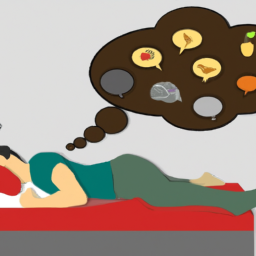Dealing with vivid dreams can be challenging, especially if they occur often. If you’re taking Lexapro, you may have noticed that this medication can cause intense and vivid dreams, leaving you feeling exhausted and unsettled upon waking. It’s important to remember that these side effects are typical and typically temporary, but there are steps you can take to minimize their impact on your daily life.
As someone who has experienced the unsettling nature of vivid dreams while taking Lexapro, I understand how frustrating it can be to feel like your sleep is out of your control. However, by working closely with your healthcare provider and implementing certain lifestyle changes, you can take steps towards reducing the frequency and intensity of these dreams.
In this article, we’ll explore some of the most effective ways to stop vivid dreams on Lexapro so that you can get back to enjoying restful sleep each night.
Key Takeaways
- Good sleep hygiene habits can improve sleep quality and reduce the intensity of vivid dreams while taking Lexapro.
- Relaxation techniques such as meditation, deep breathing, and progressive muscle relaxation can help calm the mind before bed and improve sleep quality.
- Regular exercise and incorporating activities like yoga or stretching before bed can significantly reduce the frequency and intensity of vivid dreams experienced while taking Lexapro.
- Coping strategies such as dream interpretation, relaxation techniques, and seeking support from a trusted friend or family member or therapist are important in managing vivid dreams on Lexapro. It’s important to be patient and practice self-care when dealing with medication-related side effects.
Understanding Why Lexapro Causes Vivid Dreams
Lexapro messes with your brain chemistry, making it more likely for your mind to conjure up vivid and sometimes unsettling dreamscapes. This happens because Lexapro affects the levels of serotonin in your brain, a neurotransmitter that regulates mood, sleep, and dreaming.
When you take Lexapro, it increases the amount of serotonin available in your brain, which can lead to more intense and memorable dreams. Dreams are a complex phenomenon that can be influenced by many factors including emotions, memories, and experiences.
Some people find that their vivid dreams on Lexapro have symbolic or metaphorical meanings that reflect their innermost thoughts and feelings. If you’re curious about what your dreams might mean, you could try keeping a dream journal or talking to a therapist who specializes in dream interpretation.
However, if you’re struggling with the side effects of Lexapro’s effect on serotonin and want to reduce the intensity of your dreams, there are some practical steps you can take.
Talk to Your Doctor
If you’re experiencing intense dreams, it’s important to bring it up with your healthcare provider. Your doctor can assess the severity of your symptoms and recommend the best course of action. They may suggest therapy sessions to help you cope with the vivid dreams or switch you to an alternative medication that doesn’t cause this side effect.
It’s worth noting that therapy isn’t just about talking through your problems; there are many benefits of therapy that extend beyond simply venting. Therapy can equip you with practical tools for managing stress and anxiety, which in turn can improve your sleep quality and reduce the intensity of your dreams.
Additionally, there are other medications available that may not cause vivid dreams as a side effect. Ultimately, working with your doctor to find a solution that works for you is key to getting back to restful nights without unsettling dreams.
With this in mind, let’s move onto some tips for improving sleep hygiene.
Practice Good Sleep Hygiene
To improve your sleep and wake up feeling refreshed, try practicing good sleep hygiene habits like creating a comfortable sleep environment, avoiding caffeine before bed, and establishing a consistent bedtime routine. The importance of consistency cannot be stressed enough when it comes to getting quality sleep. Going to bed and waking up at the same time each day can help regulate your body’s natural sleep cycle, making it easier for you to fall asleep and stay asleep throughout the night.
Creating a sleep-friendly environment is also crucial in improving your overall sleep quality. This includes things like making sure your bedroom is cool, quiet, and dark, investing in comfortable bedding and pillows, and removing any distractions that may keep you from falling asleep. A simple way to ensure that your sleeping space promotes relaxation is by using the following table:
| Bedroom Elements | Sleep-Friendly Tips |
|---|---|
| Lighting | Use low-wattage bulbs or dimmer switches |
| Temperature | Keep bedroom between 60-67 degrees Fahrenheit |
| Bedding | Invest in high-quality bedding made from breathable materials |
By making these small adjustments to your sleeping environment and routine, you can decrease the likelihood of having vivid dreams while on Lexapro. Now let’s discuss how avoiding stimulants before bed can further improve your chances of getting restful sleep.
Avoid Stimulants Before Bed
You may not realize it, but consuming stimulants before bed can significantly disrupt your sleep. According to a study published in the Journal of Clinical Sleep Medicine, caffeine consumed up to six hours before bedtime can reduce total sleep time by an average of one hour.
This means that even if you don’t feel wired or jittery from drinking coffee or energy drinks later in the day, the caffeine is still affecting your body’s ability to relax and enter deep sleep. Alcohol is another substance that can affect dream intensity and overall quality of sleep.
While it may initially make you feel drowsy and relaxed, alcohol actually disrupts REM (rapid eye movement) sleep, which is when most dreams occur. Instead of feeling well-rested after a night of heavy drinking, you may wake up feeling groggy and unable to remember any dreams at all.
To combat these effects and promote more restful sleep while taking Lexapro, consider creating a relaxing bedtime routine that doesn’t involve any stimulating substances like caffeine or alcohol. Try reading a book, meditating, or taking a warm bath instead. By establishing healthy habits for winding down at night, you’ll be better equipped to tackle vivid dreams while on medication without having to resort to drastic measures like stopping treatment altogether.
Now that we’ve covered how avoiding stimulants before bed can improve your chances of getting restful sleep on Lexapro, let’s explore some relaxation techniques you can try out next time you’re struggling with intense dreaming episodes.
Try Relaxation Techniques
When I’m struggling with vivid dreams on Lexapro, I’ve found that relaxation techniques can be helpful in calming my mind before bed.
Some techniques I’ve tried are meditation and mindfulness, deep breathing, and progressive muscle relaxation. These practices have helped me to release tension and anxiety, leading to a more peaceful sleep experience.
Meditation and Mindfulness
Relax and center yourself by practicing meditation and mindfulness techniques to potentially reduce the intensity of your vivid dreams while taking Lexapro. Mindfulness techniques, such as focusing on the present moment without judgment, can help calm your mind and body before bed. Guided meditations can also be helpful in promoting relaxation and reducing anxiety.
To incorporate mindfulness into your bedtime routine, try setting aside time each night to practice deep breathing or a guided meditation. There are many apps available that offer guided meditations specifically designed for sleep, such as Headspace or Calm. Additionally, you can try incorporating mindfulness throughout your day by taking short breaks to focus on your breath or surroundings. Remember that developing a regular mindfulness practice takes time and patience, but it can ultimately lead to better sleep and decreased vivid dreams.
Transitioning into the next section about deep breathing and progressive muscle relaxation: Another way to promote relaxation before bed is through deep breathing exercises and progressive muscle relaxation techniques.
Deep Breathing and Progressive Muscle Relaxation
Take control of your body’s relaxation response with deep breathing and progressive muscle relaxation, both effective techniques for promoting calmness and reducing stress.
Deep breathing helps slow down your heart rate, lower blood pressure, and regulate oxygen flow throughout your body. By focusing on taking slow, deep breaths in through your nose and out through your mouth, you can activate the parasympathetic nervous system responsible for calming the body’s stress response.
Progressive muscle relaxation involves tensing specific muscle groups one at a time before releasing them to promote a sense of deep relaxation. This technique not only reduces physical tension but also helps clear the mind of any racing thoughts or worries that may be contributing to vivid dreams while on Lexapro.
To get started with progressive muscle relaxation, find a quiet place where you won’t be disturbed and work from your toes up to the top of your head, clenching each muscle group for about five seconds before releasing it.
By incorporating these simple techniques into your daily routine, you can help alleviate some of the side effects associated with Lexapro and enjoy a more peaceful night’s sleep.
To further improve sleep quality while on Lexapro, it’s important to exercise regularly to increase endorphins and reduce stress levels. Regular physical activity can also help reset circadian rhythms that may have been disrupted by medication use.
Exercise Regularly
Regular exercise can significantly reduce the frequency and intensity of vivid dreams experienced while taking Lexapro. Studies have shown that individuals who exercised for at least 30 minutes per day reported a 45% decrease in unpleasant dream occurrences.
Regular exercise not only improves physical health but also has numerous benefits on mental health, including reducing stress and anxiety levels, which can contribute to better sleep quality. To maximize the benefits of regular exercise, it’s recommended to work out during the morning or early afternoon hours. This timing allows for adequate time for the body to cool down before bedtime and helps promote a restful night’s sleep.
Incorporating activities such as yoga or stretching before bed can also aid in relaxation and improve sleep quality. In addition to regular exercise, some individuals may consider using sleep aids to improve their overall sleep quality. However, it’s important to consult with a healthcare provider before starting any new medication or supplement regimen.
Consider Sleep Aids
Sometimes it can be helpful to try sleep aids under the guidance of a healthcare provider in order to improve overall sleep quality. Natural remedies like chamomile tea, valerian root, and lavender oil have been shown to aid with relaxation and promote better sleep. Alternative therapies such as acupuncture and meditation have also been effective for some people struggling with sleep issues.
Before considering any type of medication or alternative therapy, it’s important to talk to your healthcare provider about potential risks and benefits. They may recommend a specific type of sleep aid or suggest trying other lifestyle changes first. It’s important to remember that while sleep aids can be useful in the short-term, they shouldn’t be relied on as a long-term solution for poor sleep habits.
If you do decide to try out natural remedies or alternative therapies, it’s important to keep track of how they affect your dreams. Keeping a dream journal can help you identify patterns and triggers that may contribute to vivid dreams.
In the next section, we’ll explore how keeping a dream journal can help you gain insight into your subconscious mind.
Keep a Dream Journal
Keeping a dream journal has been a game-changer for me in managing the vivid dreams I experience while taking Lexapro.
By recording my dreams, I’m able to identify triggers and patterns that may be contributing to their intensity.
This knowledge has empowered me to make lifestyle changes and seek additional support from my healthcare provider as needed.
Recording Your Dreams
Capturing the vivid dreams on paper can be like catching fireflies in a jar. It requires patience, persistence, and precision to capture the essence of each dream. Dream interpretation is an important aspect of recording your dreams as it helps you understand the underlying meanings behind them.
Lucid dreaming, where you become aware that you’re dreaming while still in the dream state, can also be recorded and analyzed for deeper insights.
To record your dreams effectively, follow these three sub-lists:
- Keep a pen and notebook by your bedside to write down details as soon as you wake up.
- Write down as much detail as possible including emotions, colors, sounds, or smells.
- Use drawings or sketches to help capture specific details that may be hard to describe in words.
By recording your vivid dreams regularly, you’ll begin to identify patterns and triggers that might be contributing to their intensity.
In my next section about identifying triggers and patterns without writing ‘step’, I’ll discuss how recognizing these patterns can help reduce the frequency of vivid dreams.
Identifying Triggers and Patterns
Recording your dreams is an excellent way to start identifying triggers and patterns that may be causing vivid dreams on Lexapro. Once you have a few entries, it’s time to take a closer look at what’s going on in your subconscious mind.
Identifying triggers can be challenging since they can range from physical ailments to emotional stressors. However, by keeping track of when you experience vivid dreams, what you eat before bed, and any significant life events that might be impacting your mental state, you can start to see patterns emerge.
Once you’ve identified possible triggers for your vivid dreams, it’s time to develop some coping strategies. One helpful technique is dream interpretation. By analyzing the contents of your dreams and identifying any recurring themes or symbols, you can gain insight into what’s going on in your psyche.
Additionally, practicing relaxation techniques like meditation or deep breathing before bed can help calm the mind and reduce anxiety that might contribute to vivid dreaming. With these tools at your disposal, hopefully, you’ll begin experiencing more peaceful nights of sleep soon.
As important as individual coping strategies are when dealing with vivid dreams on Lexapro, sometimes seeking support from others is necessary too.
Seek Support
You need to reach out for support if you’re struggling with vivid dreams while taking Lexapro. It can be tough to deal with these intense dreams, and having someone to talk to about your experiences can make all the difference.
Finding support can take many forms: talking to a trusted friend or family member, joining an online community of people who are going through the same thing, or even seeking professional help from a therapist. Coping strategies are also important when dealing with vivid dreams on Lexapro.
Some people find that practicing relaxation techniques like deep breathing or meditation before bed can help calm their minds and reduce the likelihood of vivid dreams. Others may benefit from journaling their thoughts and feelings before sleep as a way of processing any emotions that may be contributing to their dream patterns.
Whatever strategy works best for you, know that it’s okay to ask for help and take time for self-care as you navigate this experience. Remember to be patient with yourself – finding solutions takes time and effort, but it’s possible.
Be Patient
Don’t rush the process, it’s important to give yourself time and be patient when dealing with the side effects of medication such as vivid dreams on Lexapro. It can be frustrating to experience these side effects, but it’s important to remember that they are temporary and will likely improve over time.
While waiting for the side effects to subside, there are coping strategies that can help manage the frustration. One helpful strategy is practicing relaxation techniques such as meditation or deep breathing exercises before going to bed. Another strategy is creating a calming bedtime routine such as taking a warm bath or reading a book before turning off electronics and going to sleep. Remember, patience and self-care are key in managing any medication-related side effects.
Frequently Asked Questions
How long does it take for Lexapro to start affecting dreams?
I have found that it usually takes about 2-4 weeks for Lexapro to start affecting my dreams. While managing side effects, I prioritize sleep hygiene by establishing a consistent sleep schedule and avoiding caffeine before bed.
Can reducing the dosage of Lexapro help reduce vivid dreams?
Reducing the dosage of Lexapro may help with reducing vivid dreams. However, it’s important to consult with a healthcare provider before making any changes to medication. Alternative medications may also be considered based on individual needs and symptoms.
Are there any natural supplements or remedies that can help reduce vivid dreams while taking Lexapro?
As someone who has struggled with vivid dreams on Lexapro, I’ve found relief through herbal remedies and lifestyle changes. Exploring the connection between diet and dream intensity can also provide alternatives for managing this side effect.
Can vivid dreams on Lexapro be a sign of other underlying conditions?
Vivid dreams on lexapro can sometimes be a sign of underlying causes such as anxiety or depression. It’s important to discuss with a healthcare provider as it may have a psychological impact and require further evaluation.
Is it safe to abruptly stop taking Lexapro if the vivid dreams become too overwhelming?
Abrupt withdrawal from Lexapro can cause unpleasant symptoms like dizziness and irritability. It’s important to talk to your doctor about tapering off slowly and explore alternative therapies. Remember, seeking help is a sign of strength.
Conclusion
Well folks, that’s all she wrote. Or should I say, that’s all I dreamed of writing? Ha ha, just a little joke to lighten the mood after discussing such a serious topic.
But in all seriousness, dealing with vivid dreams on Lexapro can be a real nightmare. It’s important to understand why this side effect occurs and to talk to your doctor about potential solutions like practicing good sleep hygiene or trying relaxation techniques.
Of course, if those methods don’t work for you, there are always sleep aids available. Just be sure to use them responsibly and under the guidance of a medical professional.
And remember, keeping a dream journal and seeking support from loved ones can also be helpful in coping with these intense dreams. So hang in there friends, sweet dreams (or at least less vivid ones) are possible!










